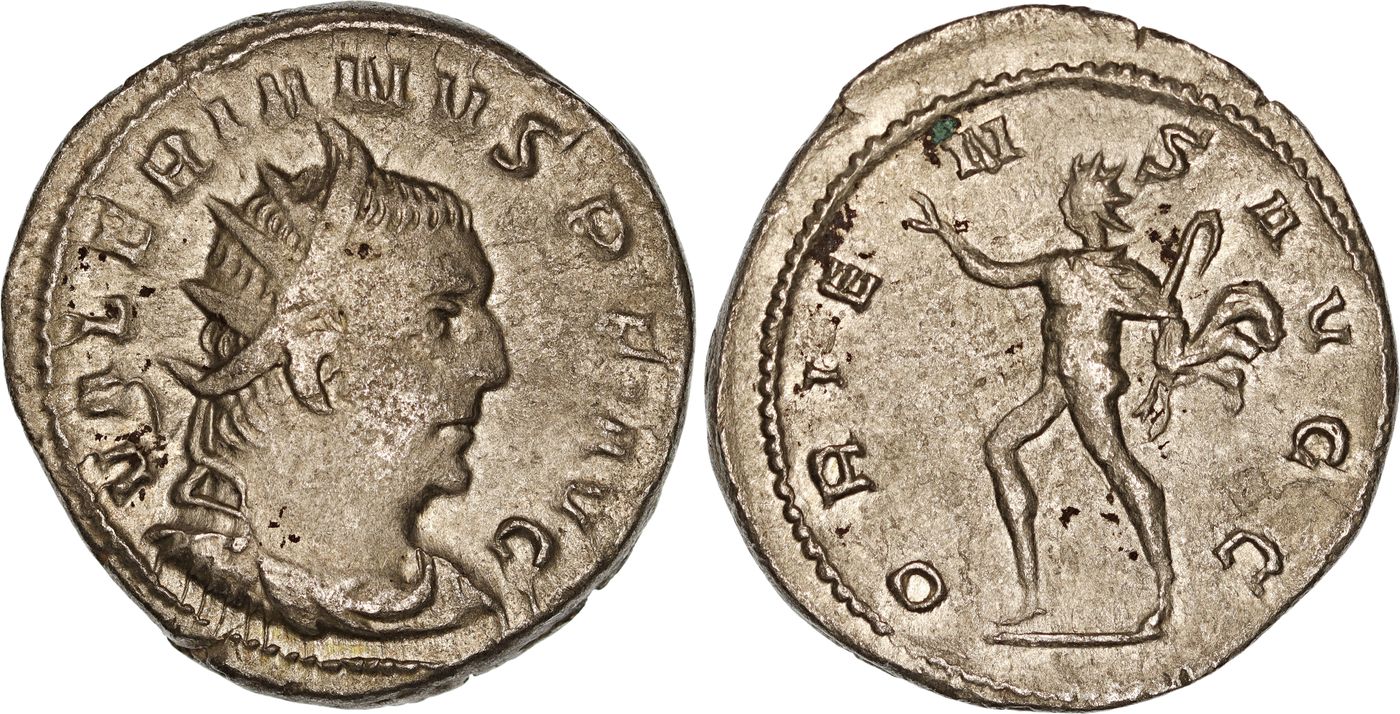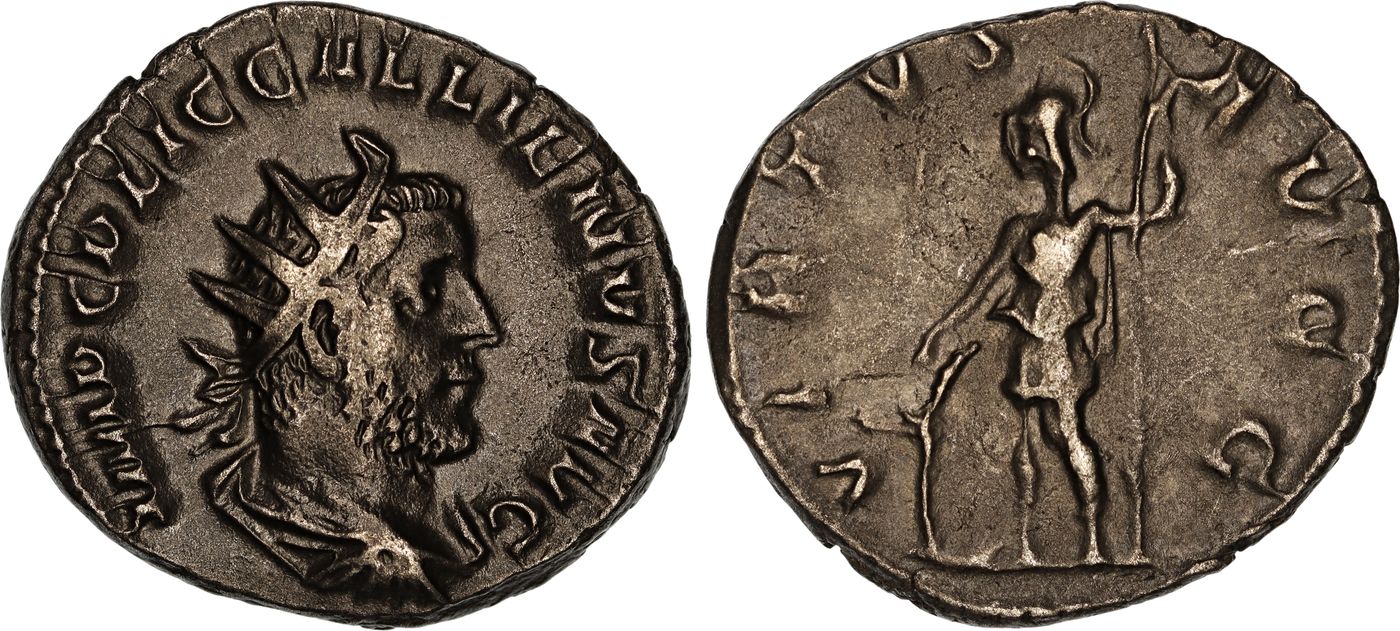The Tragedy of the House of Valerianus (gens Licinia)

Introduction: The Crisis
The ‘Crisis of the Third Century’ began with the assassination of Mārcus Aurēlius Sevērus Alexander (Severus Alexander), the last emperor of the Severan Dynasty, in 235 AD, and was a period in which the Roman Empire nearly collapsed under the combined pressure of repeated foreign invasions, civil wars and economic decline. Over this 49 year span, there was at least 26 men claiming the title of Emperor, with many only reigning for several months before their assassination, and the Empire saw increased levels of barbarian invasion and migration into Roman territory, peasant rebellions, multiple usurper emperors, and the formation of ‘break-away’ empires such as the Gallic and Palymyrene. Economic decline followed with a breakdown in both trade networks and economic productivity, leading to massive debasement of currency – the debasement of the Denarius and Antoninianus. It is generally accepted that the accession of Gāius Aurēlius Valerius Dioclētiānus (Diocletian) to Augustus in 284 AD is the endpoint of the Crisis.
Prelude: Trebonianus Gallus & Aemilian
Commander of the Moesian legions, Mārcus Aemilius Aemiliānus (Aemilian) was proclaimed emperor by the legions under his command following his great victory against the Goths in 253 AD. Quick to further his claim as emperor, Aemilian moved to Italy where he confronted the current emperor Gaius Vibius Trebonianus Gallus (Trebonianus Gallus), who, at the Battle of Interamna Nahars, was betrayed and killed by his own troops. Much like his predecessor Trebonianus Gallus, however, Aemilian would also be murdered by his soldiers after only 3 months as emperor when another Roman general, Publius Licinius Valerianus (Valerian I), was proclaimed Augustus and advanced on his position.

Pictured: Aemilian, Silver Antoninianus (3.23 g, 22 mm), Rome mint 253 AD. RIC 5b. Image courtesy of Leu Numismatik AG (Web Auction 25)
Rise of Publius Licinius Valerianus
Unlike the many others who vied for imperial power during the Third Century Crisis, Valerian was of a noble and traditional senatorial family and wished to emulate the Roman political structure of its former glory. He sought to establish a dynasty of gens Licinia, much in the image of the great dynasties which kept the empire politically stable before him – an example of which he would have witnessed firsthand as the family of Lucius Septimius Severus, the Severan Dynasty, held the throne during his early life. Therefore, upon ascending to power, Valerian elevated his firstborn son, Publius Licinius Egnatius Gallienus, to Augustus and co-ruler, and in order to combat the ever growing volatility of the empire, split the administration geographically whereby Gallienus would march west whilst his father to the east.
Pictured: The Severen Dynasty: Lucius Septimius Severus and his firstborn son Marcus Aurelius Antoninus ‘Caracalla’ on two silver Denarii.
Unfortunately, this dynastic dream would not come to fruition as not only would both the sons of Gallienus be murdered, Publius Licinius Cornelius Valerianus (Valerian II), in 258 AD at Sirmium Illyria, and Publius Licinius Cornelius Saloninus Valerianus (Saloninus) in 260 AD at Colonial Agrippina at the hands of Marcus Cassianius Latinius Postumus (Postumus), but Valerian I would meet an unprecedented fate during his Eastern campaign.
The Fall of Valerian I
Valerian I’s eastern campaign had the goal of recapturing territory lost several years earlier to constant Persian invasions, first taking Antioch in 257 AD and reclaiming the Roman province of Syria, and then moving north to address the Goths who ravaged Pontus and Cappadocia. In 259 AD, whilst moving south to aid the city of Edessa from a Persian invasion, the Romans were struck with an outbreak of the Plague of Cyprian, killing a critical number of legionaries and, compounded with several years of campaigning, reduced their fighting strength considerably. Upon arriving to the fields betwen Carrhae and Edessa in 260 AD, Valerian was met by an unweakened, larger army led by Shahanshah, the King of Kings, Shapur I of the Sassanian Empire – the clash of the two great empires, the Battle of Edessa of 260 AD, concluded with Rome’s thorough defeat and their army’s complete capture. The surviving legionaries, many high-ranked officials, possibly including the Praetorian prefect, as well as the emperor were captured; Valerian I became the first Roman Emperor to be taken as a prisoner of war, causing immense shock and instability throughout the entire Roman world.

Publius Licinius Valerianus, Roman Emperor 253-260 AD, Silver Antoninianus, Lyons mint 254 AD. RIC-12; RSC-143a; Sear-9950.

Sasanian Kingdom, Shapur I, Gold Dinar, Mint I (“Ctesiphon”), Phase 2, circa 260-272 AD. SNS type IIc/1b, style P, group d/1; Göbl type I/1; Saeedi AV5; Sunrise 740. 7.44g, 21mm, 2h. Image courtesy of Roma Numismatics Ltd. (E-sale 103)
Gallienus, a Tragic Sole Reign.
With the loss of his father and both Caesars, control of the whole empire fell to Gallienus alone who would rule for a further 8 years filled with back-to-back military engagements and socio-political unrest. Most notably, soon after Valerian’s defeat, the provinces of Britain, Spain and parts of Germania were lost to the aforementioned Postumus, the general and now Romano-Gallic Emperor responsible for the death of Saloninus, when he would declare the area an offshoot realm, now known as the Gallic Empire. Although confronted several times in battle, each would end in standstill and Postumus’ new empire would remain independent until 274 AD when it was conquered by Lucius Domitius Aurelianus.

Publius Licinius Egnatius Gallienus, as Roman Emperor and co-ruler with Valerian I 253-260 AD, Silver Antoninianus, Rome mint 254 AD. RIC-181.
It is unclear whether or not Gallienus thought the dynastic dreams of his father possible – it is likely, however, that following the murder of Saloninus so soon after the suspicious death of his first born son Valerian II, that these ambitions had diminished greatly. The emperor made no further attempt to further the imperial line of gens Licinia throughout the period of his sole reign, and never elevated another family member, Egnatius Marinianus, who was possibly a third son, to any political rank other then Consul.
In 268 AD, the emperor’s authority was challenged by Aureolus, commander of the cavalry stationed in Mediolanum, who had claimed the title of emperor. During the siege, a conspiracy was led by several high-ranking Roman officials, primarily by Cecropius, commander of the Dalmatians, who spread the word that enemy forces were surrendering. Unsuspecting of any revolt, Gallienus left his tent without his bodyguards only to be struck down by his officers. Immediately thereafter, remaining Licinius family members, the emperor’s half-brother Licinius Valerianus Minor and Egnatius Marinianus, would be murdered as well – the closing chapter to the tragedy of the House of Valerian.
Although sometimes biased, the biographies of the Historia Augusta detail the ‘tyranni trīgintā’ of Gallienus, the ‘Thirty Tyrants’ to act as pretenders to the throne of the Roman Empire during his reign; although the number is embellished, the sentiment that there was a great number of usurpers during his reign feels appropriate. Tragically, ancient historians would not treat the legacy of Gallienus favourably, highlighting his inabilities rather than what he had achieved given the circumstances – in addition to the several of his military victories, Gallienus reformed the Roman army, laying the foundation for the success of later men, notably Aurelian and Diocletian, two future emperors responsible for ending the Crisis of the Third Century.

I truly enjoy looking at on this web site, it contains excellent articles. Jonie Hugh Venterea